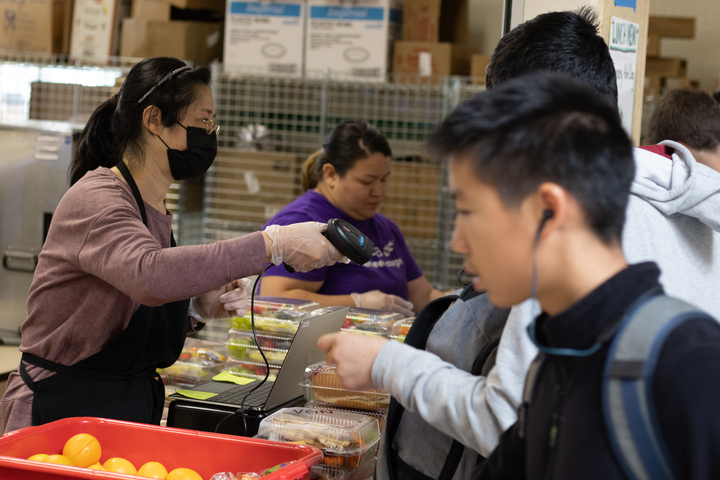Could Los Gatos’ new lunch program expand?
Palo Alto High School students pick up lunches from the Student Center cafeteria staff. According to Sophomore Sophia Ahn, the food is serviceable, but improvements could be made through a brand new system. “Considering they’re free, they’re alright,” Ahn remarks. “I think they could definitely be more nutritious and cut down on the fats and stuff, though.” (Photo: Daniel Garepis-Holland)
March 6, 2023
School districts surrounding Los Gatos are beginning to reevaluate and reform their school food systems after Los Gatos High School hired a professional chef in 2019 to improve meal quality.
Renowned chef and owner of the popular Chicago Country House, Paul Boundas, has brought his visions of healthier, nutritious and free school lunches to Los Gatos High School. The new changes by Boundas, who was deemed a ‘Miracle Worker’ by the Chicago Tribune, have spurred interest in neighboring districts, including the Palo Alto Unified School District.
PAUSD has already begun moving away from the “heat and serve ” model that is a staple for many schools nationwide. With Boundas’ introduction to Los Gatos’s kitchens, PAUSD Food Service Consultant Alva Spence describes the pressure to change the districts food service program as “tremendous.”
“I’m sure we’re not the only district under pressure,” Spence said. “Everybody’s like ‘look at the shiny new thing over there, let’s all get that. I appreciate it, but we’re nowhere near there yet. Even if I had the chef, I still couldn’t do it.”
Spence says such changes are easier said than done. Her team is working already hard to meet rising student expectations, shifting toward the new made-from-scratch model with what little they have to work with.
“It’s not that we can’t have a chef; we are actually in discussions about having a chef manager on board right now,” Spence said. “We just don’t have the facilities for it, the JLS kitchen is the largest in the district. … Paly doesn’t even have a stovetop. … [And] the Gunn kitchen doesn’t have a sink.”
According to Spence, supplies have been an obstacle for the PAUSD food service team following the pandemic.
“There’s a whole supply chain issue and fluctuation of pricing that has been horrific,” she said. “Yesterday, we couldn’t even get hot dog buns, I actually used Instacart and bought out Smart & Final in Mountain View and Costco, just so we had enough hot dog buns for the elementary school level.”
According to Boundas, he recognizes the general lack of equipment in school kitchens as the first hurdle of switching to a handmade fresh meal system.
“The general problem we’ve come across is that first you need a functional kitchen,” Boundas told the Paly Voice. “There’s those necessary things, like a flat grill and mixer, but often there’s nothing.”
However, kitchens that lack necessary facilities are something that Boundas and his team have learned to work around.
“A lot of the kitchens we go to in Chicago are maybe a hundred years old, or have outdated equipment,” Boundas said. “So, we’re very good at working with what we have. And really, the equipment we need is not high tech.”
Students at Paly are hopeful for improvements in the cafeteria system. According to junior Lucianna Peralta, because many students already rely on school meals, such changes would meet a warm welcome.
“If we do hire a private chef, I think the population that does get school lunch would really appreciate it,” Peralta said. “Some options [at Paly] have a lot of carbs. The mac and cheese … gets really cold and it’s not edible.”
However, Spence and her team are limited by state guidelines and work hard to meet them with each individual meal.
“As part of the National School Lunch program there [are] set regulations of what we have to offer to students each day,” Spence said. “I have to offer [students] five components: meat or meat alternative, grain, fruit, vegetable or milk.”
According to Spence, there is little leeway for different means because of strict regulations of components in student lunches.
“I have to input everydays’ menu into a nutrition software that is also regulated,” she said. “It pulls up everything based on recipes, and [shows if] we are within the range of high school calories, or if I’ve breached it … there is a set standard of how many times within a given week I have to offer [students] legumes, dark greens, reds, and other things.”
Some Paly students also have reservations about the cost of a new system. Junior Jonathan Liu said he is concerned about the effects a healthier lunch system would have on student accessibility.
“What would likely happen, means more people would be incentivized to come over because [of] higher quality food and then there would be longer lines,” Liu said. “That means [it’s] harder for me, who’s been eating here every single day.”
On the other hand, Los Gatos Sophomore Class President Ryan Idemoto said he is in support of the new program, and the changes implemented to address accessibility concerns.
“I feel proud about the changes made to the LGHS cafeteria system,” Idemoto told the Paly Voice in a text. “I believe progressive improvements to our school like this is a great reflection on our school and overall community values in Los Gatos. I know these changes to the food service helps out many students and creates a more inclusive environment. … It’s really important to keep up the quality and standard of the food.”
According to Idemoto, Los Gatos has different ways to mitigate crowds and long lines.
“There are now three different lines for lunch, which provides students easy access to the food,” Idemoto said. “The new program definitely incentivizes students to eat school lunch. Of course, not every lunch is a student’s favorite, but many students know that they have the provided opportunity to go get lunch for free.”
According to Liu, he acknowledges the difference a new food service program could make, but also believes there are bigger differences to be made elsewhere with the money.
“I think Paly should do whatever is best for its budget, and if that means continuing what’s happening now, that’s fine,” Liu said. “There would be a lot of difference, but I don’t know beneficial or not, and if Paly is able to utilize it in a much better way, I’d rather let them use it on stuff other than food.”
Time is also another important factor that students should keep in mind. Los Gatos Assistant Principal Kristina Grasty has worked for over six years to bring her vision of a healthier kitchen to life. Boundas’s growing reputation for assisting schools with such things drove her to get in touch with him to roll those changes around.
“I was the school administrator who launched the process of change in our food services programming starting in 2017 and initiated the partnership with Mr. Boundas in 2019,” Grasty told the Paly Voice in an email. “He is the one who has ushered in the most substantial changes including training our cafeteria staff to move to a cook-from-scratch model.”
According to Grasty, the task of transforming the kitchen is no easy feat, and the program took the efforts of many across the district to pull into effect.
“It’s been a process that has taken a lot of time, commitment, iteration and support from those directly involved as well as other school and district stakeholders but has been worth every step,” Grasty said.
Overall, though the cost and commitment needed to fully adopt the new system should be recognized, Spence believes the long-term benefits are undeniable.
“It’s not out of reach, it’s just not attainable today,” Spence said. “We’ve got to build a team who knows how to scratch-cook, which we’re already working on … [and] we need to have infrastructure in place … [the Los Gatos kitchen] is a beautiful thing, but we’re not there yet.”










![A protester in a chicken suit wearing a taco hat with the words “Cluck Trump” at the “No Kings” Democracy Fair in Palo Alto on Saturday. Protestor Mary Chan said she and her husband are horrified at the state of science and medicine in America. “What he [Trump] is doing by defunding scientific research is destroying our academic medical centers, and he’s [Trump] bankrupting rural medical centers,” Chan said. “We will have lasting negative impacts on American health for decades.”](https://palyvoice.com/wp-content/uploads/2025/10/11562FFE-9912-4152-BB01-582426B52ECB_1_105_c-225x300.jpeg)